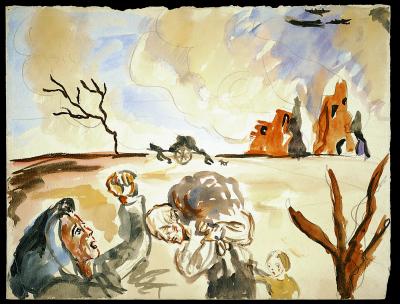February 24, 2005
Children of war: Visions of conflict, seen through innocent eyes
Tony Geist was on other business when he first saw the drawings, but he knew immediately they needed to come to the world’s attention.
“The Spanish Civil War has been a passion of mine for years,” said Geist, a UW professor who heads the Spanish and Portuguese Studies division. The conflict, he said, marked a sort of dark milestone in the evolution of warfare: “It was the first mechanized war, and the first one in which the civilian population was systematically targeted.”
Geist said he was a visiting professor at the University of California-San Diego in 1998, teaching a course on the art and literature of the Spanish Civil War, when he toured the university’s print archive. His professional life changed that day, when the archive’s director of special collections showed him a document case containing about 600 drawings from the era of that war.
“I was just stunned by these things,” Geist said with emotion.
The images were of mayhem wreaked on neighborhoods by war — filled with carnage and smoke, the horror of aerial attack and the rubble of destroyed homes — but they were not created by professional artists. The scenes were drawn by children, forced to witness events of war that no child should ever have to see.
The drawings were done by youth living in colonias infantiles, or children’s colonies, in Spain during the civil war, which lasted from 1936 to 1939. About 600,000 refugees fled to eastern Spain to escape the fascist government of Generalissimo Francisco Franco during that war, about 200,000 of them children. They were housed and educated in such colonies, which often occupied estates and country houses abandoned by their fascist owners. Geist, the father of two daughters, was deeply moved.
| Filomena Torroella, age 14, Centro Español Cerbére (France). “This drawing shows one of the houses blown up by the Fascists in Port-Bou.” |
“I said to the librarian, ‘This is extraordinary, and you should do something with it,’” Geist explained. “And she said, ‘Go ahead, do it. It’s yours.’ And so I did.”
From there, the project seemed to take on a life of its own. Working with Peter N. Carroll, chairman of the board of the Abraham Lincoln Brigade Archives — the brigade was the name under which nearly 3,000 American volunteers fought against Franco in the war — Geist created They Still Draw Pictures: Children’s Art in Wartime from the Spanish Civil War to Kosovo, an exhibit and accompanying book, released in 2002.
The project centers on selected children’s drawings from the Spanish Civil War, but also includes art works from subsequent wars. Included are images from a Japanese-American internment camp during World War II as well as others from Poland just before that war and from later conflicts in Kosovo, Sri Lanka and Burma, among other nations. One illustration is from the Vietnam War, Geist said, and one is from Iran during the 1980s. Accompanying the illustrations are vintage wartime photos by famed documentary photographer Robert Capa.
The children’s art images are divided into five categories, Geist said: before war, during war, displacement, life in the camps, and finally, visions of peace.
The exhibit has been shown at six venues nationwide, including at Dartmouth and Southern Illinois University as well as at the Axa Gallery in New York City. Its run at the UW’s Jacob Lawrence Gallery, from March 2 to April 1, will be its last. At the UW, the exhibit was preceded by a film series titled El Ojo Herido (The Wounded Eye), which concluded on Tuesday. Geist and Carroll’s book will be available at the gallery.
| Luisa Rodriguez, age 11, Bilbao Colonia Infantil de Bayona (France). “This drawing is the evacuation of my mother, my brother and me as we were leaving for Santander. And the cannons shot shells that set Mt. Arraiz on fire.” |
Accompanying the exhibit at the UW will be a symposium called “Children of War” on Friday and Saturday, March 4 and 5, in 102 Smith. Geist will convene veterans and survivors of the Spanish Civil War along with artists, archivists, scholars and children’s rights activists “to explore,” as his advance notes state, “the transformation of trauma and memory in art and expression.” As he did at UC-San Diego, Geist is teaching an accompanying course this quarter on the poetry and politics of the Spanish Civil War.
Geist said he made efforts to contact the creators of the evocative drawings, and tracked down about 12 of them. He recalled an instance when he phoned one of the artists, now in his senior years, and said, “I’m looking at a drawing you did 60 years ago.” The experience, he said, was “very emotional, very powerful.”
The exhibit and book, in Geist’s view, underscore two main points. First, “I understood the exhibit as a powerful anti-war statement — a demonstration of trauma and violence wrought upon the most innocent of victims by war.” Second, he said, “The drawings stand as a testimony of the strength of the human spirit, to create works of beauty out of trauma.” In a way, they are like the drawings any child will produce, he said, “and yet so different.”
The exhibit is being sponsored by the Simpson Center for the Humanities, the Division of Spanish and Portuguese, the Jacob Lawrence Gallery and the Office of the Associate Dean for the Humanities at the UW.
Of the experience, Geist said, “In many ways, it has exceeded my expectations. This has been the most — ‘satisfying’ is not quite the word — I feel it’s the most significant work that I have done.”
And throughout his work, he said he thought often of the young victims of the world’s current wars. “What struck me was, this is a historical problem, but it is also a current, ongoing problem.” He said the children of war-torn Iraq have been “enormously” on his mind as he worked.
Of those children, Geist said, “I can only hope there will be enough paper and crayons.”
| Rafaela Jover Rodgiguez, age 13, Colonia Escolar Bellus (Valencia), “During the Trip.” |





